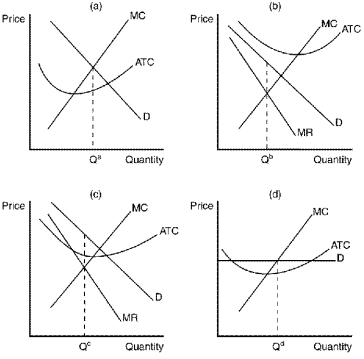B) False
Correct Answer

verified
Correct Answer
verified
True/False
Monopolistic competition is characterized by many buyers and sellers,product differentiation,and barriers to entry.
B) False
Correct Answer

verified
Correct Answer
verified
Multiple Choice
A monopolistically competitive firm chooses the quantity to produce where
A) price equals marginal cost.
B) demand equals marginal cost.
C) marginal revenue equals marginal cost.
D) Both a and c are correct.
F) A) and C)
Correct Answer

verified
Correct Answer
verified
Multiple Choice
Advertising
A) provides information about products,including prices and seller locations.
B) has been proven to increase competition and reduce prices compared to markets without advertising.
C) signals quality to consumers,because advertising is expensive.
D) All of the above are correct.
F) C) and D)
Correct Answer

verified
Correct Answer
verified
Multiple Choice
When a profit-maximizing firm in a monopolistically competitive market is in long-run equilibrium,
A) the demand curve will be perfectly elastic.
B) price exceeds marginal cost.
C) marginal cost must be falling.
D) marginal revenue exceeds marginal cost.
F) B) and D)
Correct Answer

verified
Correct Answer
verified
Multiple Choice
Among the following situations,which one is least likely to apply to a monopolistically competitive firm?
A) profit is positive in the short run
B) total cost exceeds total revenue in the short run
C) profit is positive in the long run
D) total revenue equals total cost in the long run
F) B) and D)
Correct Answer

verified
Correct Answer
verified
Multiple Choice
When a profit-maximizing firm in a monopolistically competitive market charges a price higher than marginal cost,
A) the firm must be earning a positive economic profit.
B) the firm may be incurring economic losses
C) there is a deadweight loss to society,but it is exactly offset by the benefit of excess capacity.
D) new firms will enter the market in the long run.
F) C) and D)
Correct Answer

verified
Correct Answer
verified
Multiple Choice
In comparison to perfect competition,monopolistic competition is characterized by
A) efficient scale.
B) pricing at marginal cost.
C) excess capacity.
D) All of the above are correct.
F) All of the above
Correct Answer

verified
Correct Answer
verified
Multiple Choice
Critics of advertising argue that advertising
A) creates demand for products that people otherwise do not want or need.
B) lowers barriers to entry into an industry because new firms can more easily establish themselves as competitors.
C) increases competition by providing information about prices.
D) encourages monopolization of markets by raising entry barriers.
F) A) and C)
Correct Answer

verified
Correct Answer
verified
Multiple Choice
When a profit-maximizing firm in a monopolistically competitive market is producing the long-run equilibrium quantity,
A) its average revenue will equal its marginal cost.
B) its marginal revenue will exceed its marginal cost.
C) it will be earning positive economic profits.
D) its demand curve will be tangent to its average-total-cost curve.
F) All of the above
Correct Answer

verified
Correct Answer
verified
True/False
For a profit-maximizing firm in a monopolistically competitive market,when price is equal to average total cost,price must lie above marginal cost.
B) False
Correct Answer

verified
Correct Answer
verified
Multiple Choice
Among arguments for and against advertising,both sides agree that advertising leads to
A) higher prices and less competitive markets.
B) higher prices and more competitive markets.
C) lower prices and more competitive markets.
D) None of the above is correct.The debate fails to resolve the question of advertising's effect on prices and competition.
F) None of the above
Correct Answer

verified
Correct Answer
verified
Multiple Choice
Figure 16-5  -Refer to Figure 16-5.Which of the graphs depicts a monopolistically competitive firm in long-run equilibrium?
-Refer to Figure 16-5.Which of the graphs depicts a monopolistically competitive firm in long-run equilibrium?
A) panel a
B) panel b
C) panel c
D) None of the above is correct.
F) A) and C)
Correct Answer

verified
Correct Answer
verified
Multiple Choice
In the long run,
A) monopolistically competitive firms earn a higher profit than perfectly competitive firms because monopolistically competitive firms have some monopoly power.
B) monopolistically competitive firms produce a higher output than perfectly competitive firms because competition drives the perfectly competitive firm's output down.
C) both monopolistically competitive and perfectly competitive firms produce where P = MC.
D) both monopolistically competitive and perfectly competitive firms produce where P = ATC.
F) A) and C)
Correct Answer

verified
Correct Answer
verified
Multiple Choice
Suppose that monopolistically competitive firms in a certain market are earning positive profits.In the transition from this initial situation to a long-run equilibrium,
A) the number of firms in the market decreases.
B) each existing firm experiences a decrease in demand for its product.
C) each existing firm experiences a rightward shift of its marginal revenue curve.
D) each existing firm experiences an upward shift in its average total cost curve.
F) B) and C)
Correct Answer

verified
Correct Answer
verified
Multiple Choice
In his 1958 book,The Affluent Society,John Kenneth Galbraith argued that
A) brand names give firms an incentive to produce and sell high-quality products.
B) consumers' tastes cannot,in any real sense,be "determined" by advertising.
C) firms use advertising to create demand for products that people otherwise do not want or need.
D) firms use advertising to send a signal to consumers about the quality of their products.
F) All of the above
Correct Answer

verified
Correct Answer
verified
Showing 401 - 416 of 416
Related Exams